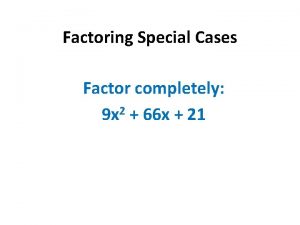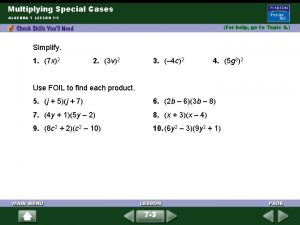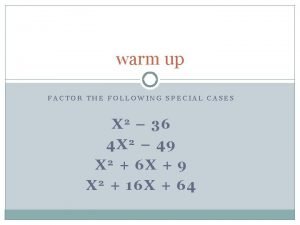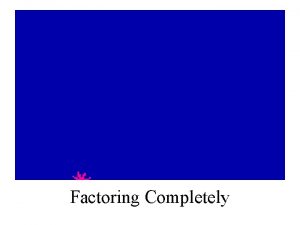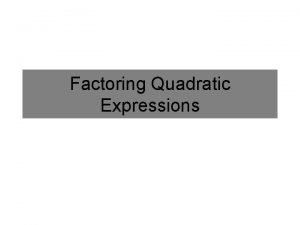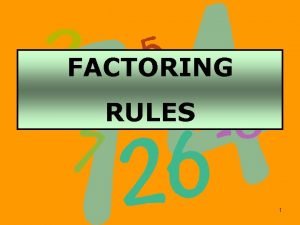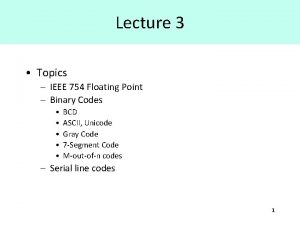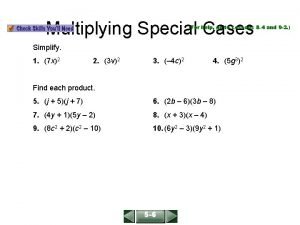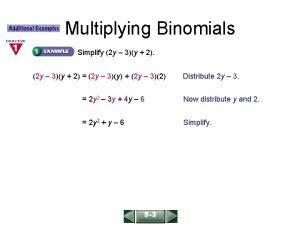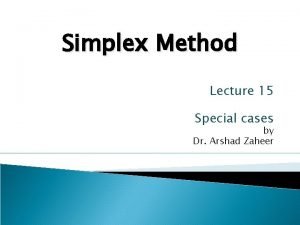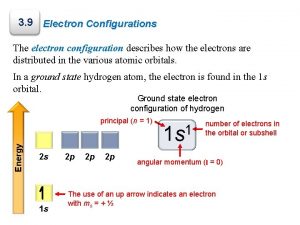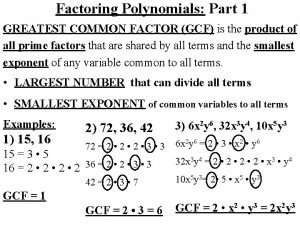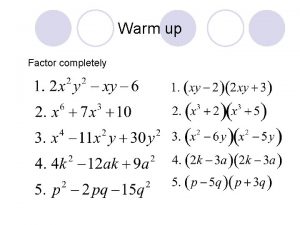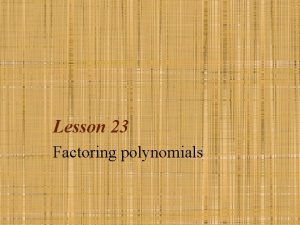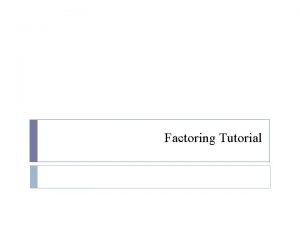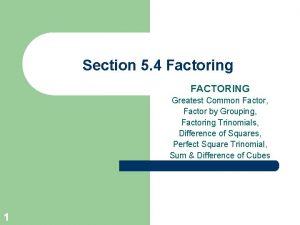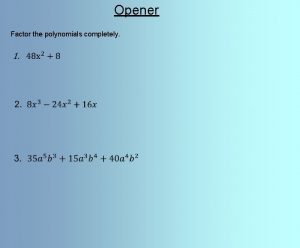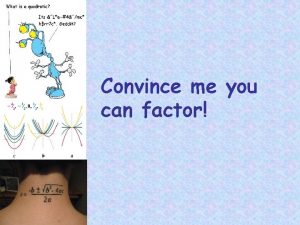Factoring Special Cases Factor completely 2 9 x


















- Slides: 18

Factoring Special Cases Factor completely: 2 9 x + 66 x + 21

Difference of Perfect Squares For all numbers a and b, a 2 – b 2 = (a-b) (a+b) Example 1: (x 2 - 25) Since 25 is a perfect square: Therefore: a 2 = x 2 and x a = ___ and b 2 = 25 5 b = ___ Solution: (x 2 - 25) = ( x - 5 ) ( x + 5 )

Example 2: 10 x 2 - 40 2 – 4) 10 (x • First factor out the 10: _____ • Now we have a difference of perfect squares ( x 2 and 4 ) • Note that it has to be a difference so the inner and outer products cancel each other out. Solution: 10 ( x-2 ) ( x+2 )

Perfect Square Trinomials Example 3: x 2 + 12 x + 36 (ax 2 + bx + c) To identify a perfect square trinomial, 1) See if a (1) and c (36) are perfect squares. 2) Multiply square roots of a & c & 2. ________ x 6 x 2 =b 12 3) If the answer 1 equals (12), you have a perfect square trinomial. _________________ x+6 4) Factor by adding/subtracting x + 6 the 2 square roots.

Example 4: 4 x 2 – 24 x + 36 • Are a(4 ) and 36 c( ______ Yes ) perfect squares? Yes: 2 x 6 x 2 = 24 Yes • Does √a x √c x 2 = b? ______________ Subtract • Do we have a perfect square trinomial? ______ 2 x – 6 2 x - 6 2 x – 6 2 • Do we add or subtract the square roots?

Perfect Square Trinomials What are the factors? l x 2 + 6 x + 9 = (x+3)2 2 2 (x-5) l x - 10 x + 25 = 2 l x 2 + 12 x + 36 = (x+6)

Solving Quadratic Equations by Completing the Square Is x 2 - 10 x + 25 a Perfect Square Trinomial? How do you know? What are its Factors?

Creating a Perfect Square Trinomial l In the following trinomial, the constant term is missing. X 2 + 14 x + ____ Find the constant term by squaring half the coefficient of the linear term to make it a perfect square trinomial. (14/2)2 X 2 + 14 x + 49

Perfect Square Trinomials Create perfect square trinomials. l x 2 + 20 x + ___ l x 2 - 4 x + ___ l x 2 + 5 x + ___ 100 4 25/4

Solving Quadratic Equations by Completing the Square Solve the following equation by completing the square: Step 1: Move quadratic term, and linear term to left side of the equation and the constant to the right side.

Solving Quadratic Equations by Completing the Square Step 2: Find the term that completes the square on the left side of the equation. Add that term to both sides.

Solving Quadratic Equations by Completing the Square Step 3: Factor the perfect square trinomial on the left side of the equation. Simplify the right side of the equation. (x+4) = 36 (x+4)2 = 36

Solving Quadratic Equations by Completing the Square Step 4: Take the square root of each side

Solving Quadratic Equations by Completing the Square Step 5: Set up the two possibilities and solve

Completing the Square-Example #2 Solve the following equation by completing the square: 2 n 2 + 12 n + 10 = 0 Step 1: Move quadratic term, and linear term to 2 n 2 + 12 n = -10 left side of the equation, the constant to the right side of the equation.

Solving Quadratic Equations by Completing the Square Step 2: Find the term that completes the square on the left side of the equation. Add that term to both sides. The quadratic coefficient must be equal to 1 before you complete the square, so you must divide all terms by the quadratic coefficient first. 2 n 2 + 12 n = -10 2 n 2 + 6 n = -5 n 2 + 6 n + 9 = -5 + 9

Solving Quadratic Equations by Completing the Square Step 3: Factor the perfect square trinomial on the left side of the equation. Simplify the right side of the equation. n 2 + 6 n + 9 = -5 + 9 (n+3) = 4 (n+3) 2 = 4

Solving Quadratic Equations by Completing the Square Step 4: Take the square root of each side Step 5: Set up the two possibilities and solve (n+3) 2 = 4 n+3 = ± 2 n = -3 + 2 = -1 and n = -3 – 2 = -5
 Special cases factoring
Special cases factoring Factor x^2-9
Factor x^2-9 Unit 3 lesson 7 factoring special cases
Unit 3 lesson 7 factoring special cases Factoring special cases trinomials
Factoring special cases trinomials Factoring trinomials
Factoring trinomials Highest common factor
Highest common factor Criminal cases vs civil cases
Criminal cases vs civil cases Diamond factoring method
Diamond factoring method Factoring problems
Factoring problems Factoring flow chart
Factoring flow chart Ieee
Ieee Lesson 4 multiplying special cases
Lesson 4 multiplying special cases Practice 9-3 multiplying binomials answer key
Practice 9-3 multiplying binomials answer key Unbounded solution in simplex method example
Unbounded solution in simplex method example Qm for windows linear programming
Qm for windows linear programming Electron configuration
Electron configuration Greatest common factor polynomials
Greatest common factor polynomials Special factor
Special factor 7-5 factoring special products
7-5 factoring special products

